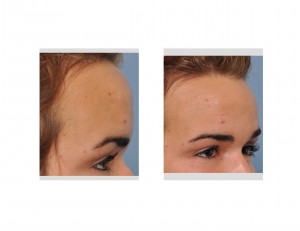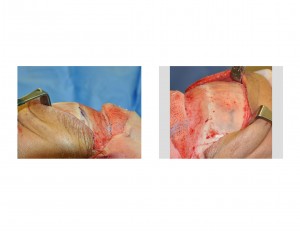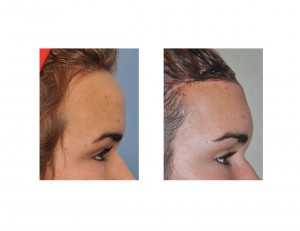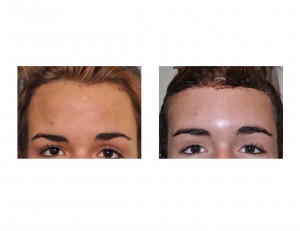Background: The appearance of the forehead, the upper third of the face, is influenced by several factors. The shape of the underlying frontal bone, the amount of forehead skin that is seen between the hairline and the eyebrows, and the degree of wrinkling in the forehead skin are all factors that create an impression. From a structural standpoint, the bone (whether the forehead is more rounded or flat) and the amount of vertical forehead skin are the fundamentals of forehead aesthetics.
The forehead should have a very slightly convex shape when seen in profile. It is never aesthetically beneficial to have a completely flat forehead but its convexity should only be slight. Too much convexity gives it a bulging or too prominent appearance. A straight line drawn from the frontal hairline to the eyebrows in profile should show only a small amount of forehead skin about it. The amount of visible forehead skin should generally be no greater than 6.5 cms between the eyebrows and the frontal hairline. This is in keeping in line with the well known anthropometric concept of the facial thirds. When it exceeds this vertical measurement, it will usually appear too long in women. For men, a long forehead is more acceptable and often completely unavoidable due to alopecia and hairline recession.

Examination showed that her hairline to brow measurement was 7.5 cms at her slight widow’s peak in the midline. The temporal hairline was even further back. In profile, there was some frontal bossing in front of the hairline which was quite evident.


An important technical point is the need to secure the scalp advancement to the bone once it is brought forward. This is done by securing it with sutures to the bone through drilled holes or suture anchors. This is important to maintain the hairline position as it heals but also take tension off of the closure to prevent scar widening.

1) The long forehead can be reduced by a scalp advancement procedure. This requires an incision along the hairline and a resultant fine-line permanent scar. Forehead bone recontouring can be done at the same time. Often when the frontal hairline is too far back, there will be an accompanying bony bulge.
2) Forehead reduction is very much the close cousin to an open hairline (pretrichial) browlift. It is, in essence, a reverse browlift.
3) While the operation sounds daunting, its recovery is quite quick with much less discomfort than one would think.
Dr. Barry Eppley
Indianapolis, Indiana



